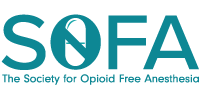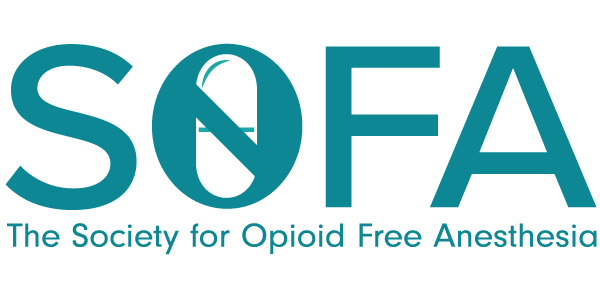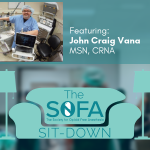SOFA Sit-Down Featuring Caroline Landry, BSN, RN, SRNA
This month’s edition of the SOFA Sit Down features Caroline Landry, BSN, RN, SRNA, who is enrolled at Louisiana State University Health and Science Center’s Doctorate Nurse Anesthesia Program (class of 2018). Tom Baribeault came across Caroline Landry’s research at a Louisiana Association of Nurse Anesthetists (LANA) meeting poster presentation, and was intrigued by this opioid-free approach to monitored anesthesia care (MAC) for hemodynamically challenging left-sided heart failure patients. Read on to see the abstract for her research study, and a short interview explaining it. Thanks Caroline Landry for taking the time to share your research with us, and we hope to see you published in the future!
The Research
Implementation of a Checklist to Monitor Mean Arterial Pressure with Left-Sided Heart Failure Patients Receiving Dexmedetomidine Before and After Monitored Anesthesia Care Procedures to Determine Hemodynamic Stability: A Knowledge to Action Project
Objective
This project includes an organized literature review and development of a Knowledge to Action Project to educate all practicing anesthesia providers at a selected medical facility on the benefits of using a dexmedetomidine+ketamine (DK) anesthetic as opposed to a propofol anesthetic on left ventricular heart failure (LVHF) patients undergoing MAC.
Background and Purpose
The lack of a recommended safe anesthetic agent for MAC in patients suffering from left ventricular heart failure poses a problem for anesthesia providers. Anesthesia providers are likely to provide anesthesia to these patients with propofol, as this is the standard drug used for MAC. The hemodynamic effects resulting from a propofol anesthetic result in a decreased blood pressure and apneic periods. A new research guided recommended MAC anesthetic agent and technique is needed for this patient population to maintain stable hemodynamics while providing an equally efficacious level of anesthesia and analgesia.
Methods
An education session was developed through the use of a Knowledge to Action framework to educate anesthesia providers regarding the hemodynamic benefits of using a DK anesthetic in the patient with LVHF. A post education survey was used to evaluate the effects of the education session to improve anesthesia providers’ willingness to use the DK anesthetic. An intraoperative tracking tool and checklist was used to evaluate the active use of the DK anesthetic in patient with LVHF undergoing monitored anesthesia care.
Results
The education session resulted in 91% of anesthesia providers educated stating they had an increased willingness to deliver a DK anesthetic to the LVHF receiving monitored anesthesia care. Greater than 10 DK anesthetics were administered to LVHF patients in a two-month period with 100% of these anesthetics displaying stable patient hemodynamics throughout the procedure.
Discussions/Conclusions
The literature review revealed that the use of a DK anesthetic provides hemodynamic outcomes that are desirable in the anesthetic management of the LVHF patient. 91% of anesthesia providers educated on this topic displayed an increased willingness to use this anesthetic in this patient population. Surveys obtained from the implementation phase revealed that anesthesia personnel not using DK anesthetic was mostly due to expense and limited drug availability, with a majority of experienced anesthesia providers showing a resistance to change.
Further studies need to be conducted to conclude the best IV anesthetic for patients suffering with LVHF. The DNP candidate suspects best practice guidelines for anesthetic management of the LVHF is the only way to invoke major change in practice.
The Interview
Why did you choose this topic to research?
I became interested in this topic during a clinical rotation at a site that delivers anesthesia to a high volume of patients with impaired heart function. I noticed that more than one provider opted to use dexmedetomidine during MAC procedures for patients with an EF less than 30%. Some providers used ketamine with this, and others didn’t. Providers stated they used dexmedetomidine over propofol as they felt it made the patient more hemodynamically stable throughout the case. I did a literature review and opted to include ketamine in my project based on what I found.
Can you provide a brief summary of your literature review?
-
- The literature review revealed there is no set standard of monitored anesthesia care for patients suffering with LVHF. The CPG written by the ACCF (2014) concluded that there is a lack of evidence to reveal whether MAC is more advantageous over general anesthesia. This reveals a notable gap in literature regarding an absent standard of care for the anesthetic management of the patient with LVHF under MAC.
- Page et al. (2016) concludes that all IV anesthetic agents have the potential to exacerbate LVHF.
- Chua & Nguyen (2015) states that anesthetic goals for the maintenance of the patient with LVHF involve avoiding coronary ischemia, pulmonary hypertension, and chronic end organ dysfunction while simultaneously promoting inotropy.
- Page et al. (2016) discussed a study on pediatric LVHF patients that revealed dexmedetomidine showed no changes in BP, HR, or inotropy. The lack of hemodynamic changes in BP and HR are ideal for this patient population as it promotes end organ perfusion by maintaining blood pressure, and avoiding coronary ischemia by preventing an increase in HR.
- Dexmedetomidine has been shown to have cardioprotective effects, and causes no impairment in systolic or diastolic cardiac function (Lee et al., 2015).
- Rasheed et al. (2015) stated a DK anesthetic provides a long duration of analgesia with high patient and surgeon satisfaction while maintaining minimal hemodynamic changes.
- Candiotti et al. (2010) revealed changes in BP and HR associated with dexmedetomidine administration are not dose dependent, meaning larger doses to obtain adequate anesthesia may be obtained without the worry of an emphasized decrease in HR.
- Wang et al. (2014) concluded that dexmedetomidine anesthesia when compared to propofol offered comparable levels of sedation, while dexmedetomidine did not cause a decrease in BP as propofol did.
- Kurdi et al. (2014) discussed that ketamine’s beneficial effects as an adjunct to IV anesthetics provides more stable hemodynamics along with minimal respiratory depression.
- Thoma et al. (2014) revealed in a cost analysis that CABG patients postoperatively sedated with dexmedetomidine required shorter length of mechanical ventilation, ICU and hospital LOS, and lower additional opioid requirements, saving an average of $2,632 per patient.
- The literature review reveals that a DK anesthetic can provide an efficacious anesthetic while maintaining the hemodynamic goals that are desired for the patient with LVHF under anesthesia.
What are the goals of anesthetic management of the patient with LVHF?
Anesthetic goals for the management of the patient with LVHF patient are focused on maintaining a balance between myocardial oxygen demand and delivery. This balance is maintained by avoiding tachycardia, hypertension, hypoxemia, diastolic hypotension, and acidosis. With these goals in mind, an anesthetic that lowers BP, such as propofol, is not ideal. The literature review showed the hemodynamic changes resulting from an anesthetic with dexmedetomidine + ketamine can provide adequate anesthesia and analgesia, while maintaining the patients’ RR, BP, and HR, which are all ideal outcomes for the patient with LVHF undergoing anesthesia.
What was the purpose of your study?
A safe, recommended anesthetic for MAC in the patient suffering with LVHF has not been previously defined. The purpose of this DNP project was to educate all participating anesthesia providers the benefits of using a DK anesthetic as an alternative to propofol for MAC in the patient with LVHF. The overall goal of this DNP project was for anesthesia providers to feel more knowledgeable and comfortable with administering this anesthetic and therefore provide more use of this anesthetic, so that HF patients receiving MAC may experience maintained perioperative hemodynamics and therefore improved patient safety.
Can you explain the development of the educational materials used in the study?
I created a PowerPoint presentation to use as a teaching aid. My objectives for the education session were for the staff at my implantation facility to be able to discuss anesthetic goals and management of the patient with LVHF, verbalize the need for current management of the LVHF patient under MAC to change for optimal hemodynamic goals, and verbalize how and why the dexmedetomidine+ketamine anesthetic is used. The development of my educational PowerPoint focused on these objectives through a synopsis of the information gained from my literature review.
How did you evaluate the results of the new education?
A Post Education Survey was administered to all anesthesia providers that participated in the education session. This survey was administered to receive demographic data about the anesthesia providers (i.e. what type of provider, how many years in practice, how often administering anesthesia to LVHF patients) and to determine if the anesthesia provider considered themselves to have increased knowledge regarding dexmedetomidine+ketamine as well as an increased willingness to use this anesthetic. Increased knowledge and willingness was assessed simply by having the anesthesia provider choose between the choices a) strongly agree, b) agree, c) N/A, d) disagree, or e) strongly disagree. 91% of the anesthesia providers educated verbalized an increased willingness to use this technique with the LVHF patient population.
Were any DK anesthetics for LVHF patients being done prior to the staff education you implemented?
The verbal feedback I received after staff education alluded me to believe the DK anesthetic was not being used in this patient population. I am sure these drugs were being used respectively, but not together for MAC procedures.
In your data collection, were you able to ascertain the number of providers who converted to using DK anesthetics for this patient population?
I administered a Sustained Use survey one month following the end of the implementation period. Ten out of twenty-five anesthesia providers (40%) verbalized in this survey that they will continue to use the DK anesthetic for this patient population.
Did you have to work with pharmacy for drug availability and approval? What were the availability issues that you encountered?
I was lucky and did not have to interact with pharmacy to get these drugs approved, as the anesthesia team already had access to both dexmedetomidine and ketamine. “Expense” was the top reported reason for anesthesia providers not administering a DK anesthetic for MAC cases for LVHF patients. Based on verbal feedback I received from anesthesia providers, I was under the impression that “expense” was something the provider was trying to be conscious of, as opposed to pharmacy limiting the drug availability. In hindsight, I could have reeducated those anesthesia providers regarding the possible decreased complications related to a DK anesthetic, saving money in the long run for earlier discharge and decreasing risk of readmission (Thoma et al., 2014). If I were to pursue this research any further, I would definitely collaborate with pharmacy so that no resistance to this anesthetic was met on the pharmacy aspect of care.
Your study seems to indicate that experienced anesthesia providers were the most resistant to change in regards to the education and application of this information. Why do you think that is?
I did not conclude that experienced anesthesia providers are the most resistant to change. A huge flaw in my project is that I only tried to assess a correlation between years of experience and willingness to deliver a DK anesthetic during my Post Education Survey. I failed to ask for anesthesia provider years of experience on my following surveys! Therefore I am sadly unable to ascertain the anesthesia providers whom did not change their practice are the ones with more experience.
I was not able to find much research regarding anesthesia provider satisfaction with dexmedetomidine +/- ketamine administration. Wang et al. (2014) does however state that when compared to patients receiving propofol for LASIK surgery, surgeon satisfaction scores were higher for patients having received dexmedetomidine for surgery. Patient satisfaction among the two groups were the same for both dexmedetomidine and propofol. Chun et al. (2016) compares the effects of dexmedetomine+ketamine (DK) to dexmedetomidine+midazolam+fentanyl (DMF) for MAC during chemoport insertion. This study concluded that patient, surgeon, and anesthesiologist satisfaction scores were highest amongst the DMF group. The study does not provide reasoning for surgeon/anesthesiologist dissatisfaction with the DK anesthetic. No patients that received the DK anesthetic report any dissatisfaction with DK, however.
I have a few thoughts to answer your question as to why I think anesthesia providers are resistant to change. I received verbal feedback from a few providers that they were opposed specifically to the ketamine portion of my project. During this project’s implementation, I learned that there are two types of anesthesia providers: those that love ketamine and those that hate it. For the providers that showed opposition to ketamine, I believed there was no amount of education I could deliver that would change their mind. I conclude that in order for there to be a bigger shift in anesthesia provider use from propofol to DK, there needs to be more research regarding the combination (or individually) and its effects on the patient with LVHF. I am, however, very thrilled that this project has been recognized by the SOFA, and I hope this project inspires more providers to try this technique.
If there’s someone you’d like to see featured on the “SOFA Sit-Down,” send an email to info@goopioidfree.com!






